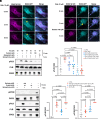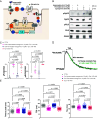Subcellular activation of β-adrenergic receptors using a spatially restricted antagonist
- PMID: 39331410
- PMCID: PMC11459184
- DOI: 10.1073/pnas.2404243121
Subcellular activation of β-adrenergic receptors using a spatially restricted antagonist
Abstract
Gprotein-coupled receptors (GPCRs) regulate several physiological and pathological processes and represent the target of approximately 30% of Food and Drug Administration-approved drugs. GPCR-mediated signaling was thought to occur exclusively at the plasma membrane. However, recent studies have unveiled their presence and function at subcellular membrane compartments. There is a growing interest in studying compartmentalized signaling of GPCRs. This requires development of tools to separate GPCR signaling at the plasma membrane from the ones initiated at intracellular compartments. We leveraged the structural and pharmacological information available for β-adrenergic receptors (βARs) and focused on β1AR as exemplary GPCR that functions at subcellular compartments, and rationally designed spatially restricted antagonists. We generated a cell-impermeable βAR antagonist by conjugating a suitable pharmacophore to a sulfonate-containing fluorophore. This cell-impermeable antagonist only inhibited β1AR on the plasma membrane. In contrast, a cell-permeable βAR antagonist containing a nonsulfonated fluorophore efficiently inhibited both the plasma membrane and Golgi pools of β1ARs. Furthermore, the cell-impermeable antagonist selectively inhibited the phosphorylation of PKA downstream effectors near the plasma membrane, which regulate sarcoplasmic reticulum (SR) Ca2+ release in adult cardiomyocytes, while the β1AR Golgi pool remained active. Our tools offer promising avenues for investigating compartmentalized βAR signaling in various contexts, potentially advancing our understanding of βAR-mediated cellular responses in health and disease. They also offer a general strategy to study compartmentalized signaling for other GPCRs in various biological systems.
Keywords: GPCR signaling; Pharmacology; drug design.
Conflict of interest statement
Competing interests statement:K.M.S. has consulting agreements for the following companies, which involve monetary and/or stock compensation: Revolution Medicines, Black Diamond Therapeutics, BridGene Biosciences, Denali Therapeutics, Dice Molecules, eFFECTOR Therapeutics, Erasca, Genentech/Roche, Janssen Pharmaceuticals, Kumquat Biosciences, Kura Oncology, Mitokinin, Nested, Type6 Therapeutics, Venthera, Wellspring Biosciences (Araxes Pharma), Turning Point, Ikena, Initial Therapeutics, Vevo and BioTheryX.
Figures




Update of
-
Selective activation of intracellular β1AR using a spatially restricted antagonist.bioRxiv [Preprint]. 2023 Nov 22:2023.11.22.568314. doi: 10.1101/2023.11.22.568314. bioRxiv. 2023. Update in: Proc Natl Acad Sci U S A. 2024 Oct;121(40):e2404243121. doi: 10.1073/pnas.2404243121. PMID: 38045405 Free PMC article. Updated. Preprint.
Similar articles
-
Selective activation of intracellular β1AR using a spatially restricted antagonist.bioRxiv [Preprint]. 2023 Nov 22:2023.11.22.568314. doi: 10.1101/2023.11.22.568314. bioRxiv. 2023. Update in: Proc Natl Acad Sci U S A. 2024 Oct;121(40):e2404243121. doi: 10.1073/pnas.2404243121. PMID: 38045405 Free PMC article. Updated. Preprint.
-
Intracellular β1-Adrenergic Receptors and Organic Cation Transporter 3 Mediate Phospholamban Phosphorylation to Enhance Cardiac Contractility.Circ Res. 2021 Jan 22;128(2):246-261. doi: 10.1161/CIRCRESAHA.120.317452. Epub 2020 Nov 13. Circ Res. 2021. PMID: 33183171 Free PMC article.
-
β2-Adrenergic Stimulation Compartmentalizes β1 Signaling Into Nanoscale Local Domains by Targeting the C-Terminus of β1-Adrenoceptors.Circ Res. 2019 Apr 26;124(9):1350-1359. doi: 10.1161/CIRCRESAHA.118.314322. Circ Res. 2019. PMID: 30836825 Free PMC article.
-
Structural insights into adrenergic receptor function and pharmacology.Trends Pharmacol Sci. 2011 Apr;32(4):213-8. doi: 10.1016/j.tips.2011.02.005. Epub 2011 Mar 15. Trends Pharmacol Sci. 2011. PMID: 21414670 Free PMC article. Review.
-
Non-canonical signaling initiated by hormone-responsive G protein-coupled receptors from subcellular compartments.Pharmacol Ther. 2025 Feb;266:108788. doi: 10.1016/j.pharmthera.2024.108788. Epub 2024 Dec 23. Pharmacol Ther. 2025. PMID: 39722422 Review.
Cited by
-
Deciphering complexity of GPCR signaling and modulation: implications and perspectives for drug discovery.Clin Sci (Lond). 2025 May 20;139(10):463-77. doi: 10.1042/CS20245182. Clin Sci (Lond). 2025. PMID: 40400289 Free PMC article. Review.
-
G Protein-Coupled Receptors: A Century of Research and Discovery.Circ Res. 2024 Jun 21;135(1):174-197. doi: 10.1161/CIRCRESAHA.124.323067. Epub 2024 Jun 20. Circ Res. 2024. PMID: 38900852 Free PMC article. Review.
-
Chemical biology approaches to resolve the subcellular GPCR signaling landscape.Nat Chem Biol. 2025 Aug;21(8):1148-1159. doi: 10.1038/s41589-025-01928-x. Epub 2025 Jun 2. Nat Chem Biol. 2025. PMID: 40456961 Free PMC article. Review.
References
-
- Pierce K. L., Premont R. T., Lefkowitz R. J., Seven-transmembrane receptors. Nat. Rev. Mol. Cell Biol. 3, 639–650 (2002). - PubMed
MeSH terms
Substances
Grants and funding
LinkOut - more resources
Full Text Sources
Research Materials
Miscellaneous

